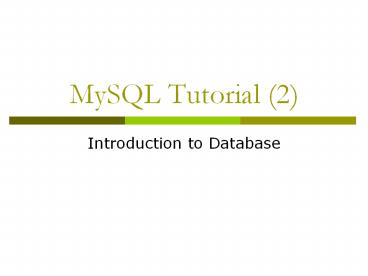MySQL Tutorial (2) - PowerPoint PPT Presentation
Title:
MySQL Tutorial (2)
Description:
Title: PowerPoint Presentation Last modified by: KSU Created Date: 1/1/1601 12:00:00 AM Document presentation format: On-screen Show Other titles – PowerPoint PPT presentation
Number of Views:442
Avg rating:3.0/5.0
Title: MySQL Tutorial (2)
1
MySQL Tutorial (2)
- Introduction to Database
2
Banking Example
- branch (branch-name, branch-city, assets)
- customer (customer-name, customer-street,
customer-city) - account (account-number, branch-name, balance)
- loan (loan-number, branch-name, amount)
- depositor (customer-name, account-number)
- borrower (customer-name, loan-number)
- employee (employee-name, branch-name, salary)
3
SQL Script for creating tables
- The SQL script for creating database bank can
be found at - http//www.cs.kent.edu/nruan/bank_db.sql
- http//www.cs.kent.edu/nruan/bank_data.sql
Notice we do not have permission to create
database, so you have to type command use
your_account to work on your database.
4
Command for accessing MySQL
- Access linux server
- gtssh hercules.cs.kent.edu
- Access MySQL
- gtmysql u username p
- gtEnter passwordpassword
5
Query
- To find all loan number for loans made at the
Perryridge branch with loan amounts greater than
1100. - select loan_number from loanwhere branch_name
Perryridge and amountgt1100 - Find the loan number of those loans with loan
amounts between 1,000 and 1,500 (that is,
?1,000 and ?1,500) - select loan_number from loanwhere amount
between 1000 and 1500
6
Query
- Find the names of all branches that have greater
assets than some branch located in Brooklyn. - select distinct T.branch_name
- from branch as T, branch as Swhere T.assets gt
S.assets and S.branch_city Brooklyn - Find the customer names and their loan numbers
for all customers having a loan at some branch. - select customer_name, T.loan_number, S.amount
from borrower as T, loan as S where
T.loan_number S.loan_number
7
Set Operation
- Find all customers who have a loan, an account,
or both - (select customer_name from depositor) union(sel
ect customer_name from borrower) - Find all customers who have an account but no
loan. - (no minus operator provided in mysql)
- select customer_name from depositor
- where customer_name not in(select
customer_name from borrower)
8
Aggregate function
- Find the number of depositors for each branch.
- select branch_name, count (distinct
customer_name)from depositor, accountwhere
depositor.account_number account.account_number
group by branch_name - Find the names of all branches where the average
account balance is more than 500. - select branch_name, avg (balance)from
accountgroup by branch_namehaving avg(balance)
gt 500
9
Nested Subqueries
- Find all customers who have both an account and a
loan at the bank. - select distinct customer_namefrom
borrowerwhere customer_name in - (select customer_name from depositor)
- Find all customers who have a loan at the bank
but do not have an account at the bank - select distinct customer_namefrom
borrowerwhere customer_name not in - (select customer_name from depositor)
10
Nested Subquery
- Find the names of all branches that have greater
assets than all branches located in Horseneck. - select branch_name from branch where assets gt
all (select assets from branch where
branch_city Horseneck)
11
Create View (new feature in mysql 5.0)
- A view consisting of branches and their customers
- create view all_customer as (select
branch_name, customer_name from depositor,
account where depositor.account_number
account.account_number) - union(select branch_name, customer_namefrom
borrower, loanwhere borrower.loan_numberloan.loa
n_number)
12
Joined Relations
- Join operations take two relations and return as
a result another relation. - These additional operations are typically used as
subquery expressions in the from clause - Join condition defines which tuples in the two
relations match, and what attributes are present
in the result of the join. - Join type defines how tuples in each relation
that do not match any tuple in the other relation
(based on the join condition) are treated.
13
Joined Relations Datasets for Examples
- Relation loan
- Relation borrower
- Note borrower information missing for L-260 and
loan information missing for L-155
14
Joined Relations Examples
- Select from loan inner join borrower
onloan.loan-number borrower.loan-number
15
Example
- Select from loan left join borrower
onloan.loan-number borrower.loan-number
16
Modification of Database
- Increase all accounts with balances over 800 by
7, all other accounts receive 8. - update account set balance balance ?
1.07 where balance gt 800 - update account set balance balance ?
1.08 where balance ? 800
17
Modification of Database
- Increase all accounts with balances over 700 by
6, all other accounts receive 5. - update account set balance case
when balance lt 700 then balance 1.05
else balance 1.06
end
18
Modification of Database
- Delete the record of all accounts with balances
below the average at the bank. - delete from account where balance lt (select
avg (balance) from account) - Add a new tuple to account
- insert into account
- values (A-9732, Perryridge,1200)































